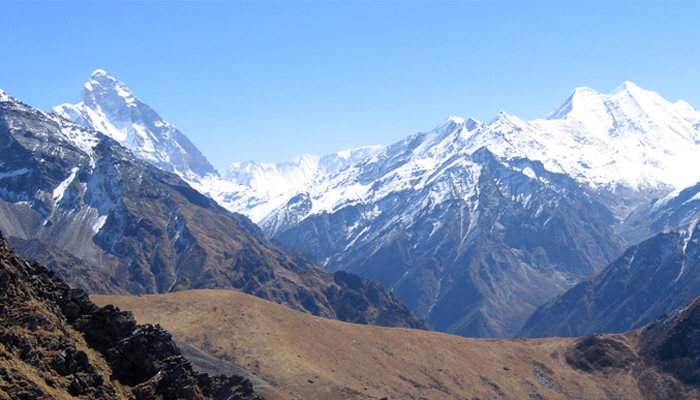Nanda Devi National Park along with the nearby Valley of Flowers was made a UNESCO World Heritage Site in 1988. Nanda Devi National Park is a forest reserve cum national park (established 1982) in the area surrounding the Nanda Devi peak and covers an area of 630.33 sq kms. The name Nandadevi has been inspired from the name of the resident deity of the area Nanda Devi (a manifestation of Goddess Parvati). The Nanda Devi peak is basically a glacial basin with a height of about 7,817 m (25,646 ft) drained by Rishi Ganga through the sharp Rishi Ganga gorge.
Location
Nanda Devi National Park is located in Chamoli district of Uttarakhand, in the transition range between the Zanskar range and Himalayan foothills.
Best Time to Visit
The Nandadevi National Park remains open only for six months, from 1st May to 31st October every year.
Rules for Visit
Visitors must move in groups and not venture alone in any condition. Each group will have five members and one registered guide has to accompany each group. A maximum of two groups per day and four groups per week are allowed. Children only above 14 years of age will be allowed for park visit. It is mandatory for all visitors to obey the list of rules and wildlife protection act inside the park area.
Suggestion
Carry woolen clothing in layers since it sometimes gets very chilly there. Take along an extra pair of sturdy trekking shoes and hiking equipment because one has to walk a lot. Apply sunscreen and mosquito repellent to save yourself from sun burns and mosquito bites. Lastly, consult your doctor before coming since high altitude may be adverse in cases of asthma or heart troubles.
Flora
The flora is found abundantly in the Nanda Devi National Park since the confluence of two mountain ranges provides a tremendous range of diversity to the area. It is known that the local populations use a total of 97 species of plants. The breakdown includes 55 as food plants, 17 for medicine, 16 for fuel, 15 as fodder, 11 for religious purposes, eight for building houses, six for miscellaneous, five as tools and two as fibers. There are also many rare and almost extinct plants like Saussurea sudhanshui, Nardostachys grandiflora, Picroehiza kurrooa, Cypripedium elegans, C. himalaicum, Dioscorea deltoidea and Allium stracheyi.
Fauna
Nanda Devi National Park is well-known for the profusion of its varied 83 species animal population. It is common to find rare species here like Bharal (Pseudois nayaur), Himalayan Musk Deer (Moschus chrysogaster), Mainland Serow (Capricornis sumatraensis), Himalayan Tahr (Hemitragus jemlahicus), Goral (Nemorhaedus goral), Snow Leopard (Panthera uncia), Common Leopard (Panthera pardus), Himalayan Black Bear (Selenarctos thibetanus), Common Langur (Presbytis entellus), Rhesus Macaque (Macaca mullata). Also, there are about 114 avian species and 27 species of butterflies alone.

